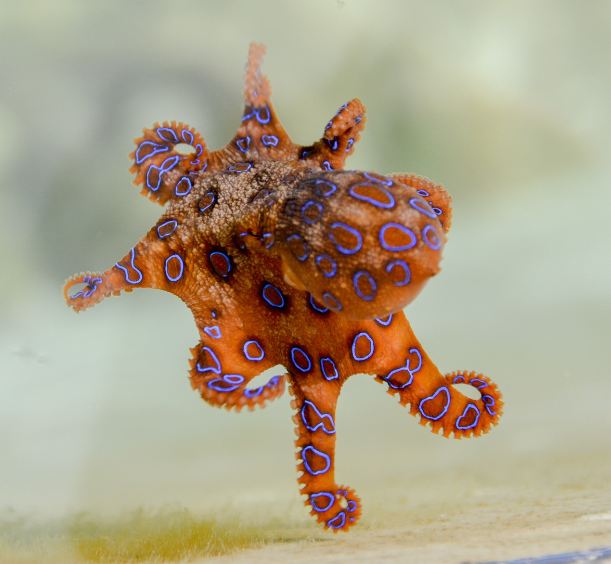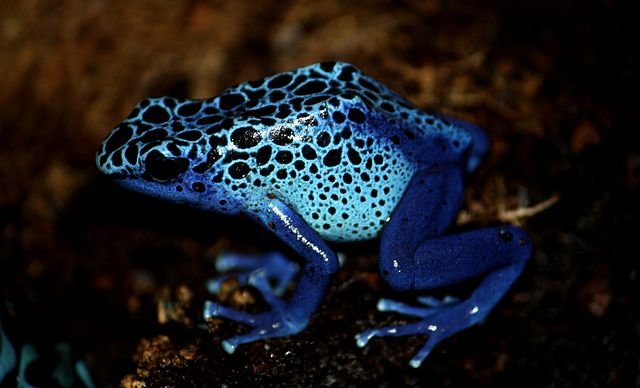Pretty blue rings of death, the bacterial basis for the octopus's venom
I just this week found out that the blue-ringed octopus (Hapalochlaena spp.) does not produce its own venom. It owes its toxic bite to the bacteria which have made a happy home in its salivary glands.
One of the gifts of nature is that there is always something new to learn. I am a huge microbiology geek, yet bugs keep popping up in different topics I'd never think to associate them with. The more I read, the more I became amazed. Come, learn with me.

Blue ringed octopus, note how it is an octopus and has blue rings. Cropped from Pixabay source under CC0.
I'm pretty sure the blue-ringed octopus is fairly well-known. It's definitely got a memorable look (aposematism), I often see it used as an example of venomous sea life, and it certainly helps that the octopus itself and its distinctive patterning were featured heavily in the Bond film Octopussy.
The exact nature of the potent poisonous pucker that paralyzes poisson is probably less well-known. There's a melange of toxins in the ocotopus' saliva, but the one which packs the most punch was originally called maculotoxin and appeared to have the same effects as tetrodotoxin (TTX). In fact, it was was later determined that maculotoxin was identical to TTX.ref
The word 'tetrodotoxin' is a mouthful, but I'm betting it is ringing a few bells for some of you. It shows up in popular fiction and in the news from time to time, mainly as the toxin associated with the pufferfish (a.k.a fugu). As it turns out, TTX can be found in many different organisms, and not just closely related marine animals. It's even in some newtsref and worms.
To a biologist, when a compound has a very potent, specific effect and appears in many diverse organisms, this raises some flags, like the 'a mystery is afoot!' flag.1

All of these things will kill you. So, naturally, we've tried to eat them. Yes, even the newt .
Adapted from sources: Puffer, crab, and newt by Bernard DuPont, Alan Schmierer and Chris 73 released under CC2, CC1, and CC3, respectively.
I'm happy to say that microbiologists cracked the case, and as early as the 80's. Using technology which, in molecular biology terms is the equivalent of sharp sticks and bits of string, researchers were able to determineref that certain bacteria in the salivary glands of the octopodeies2 produce TTX. Similar research showed that many of the other organisms associated with TTX were also relying on bacteria to produce it.
The consensus, which is still largely accepted, is that this was a classic mutualisitic relationship. The host organism got to have a badass venom, and the bacteria were given a nice little home. Mystery solved, right? Well, yesmostly, but it also lead to a bunch of other mysteries.
Why does such a thing even exist?
It turns out that it's not just a handful of bacteria which produce TTX. And among those bacteria which produce TTX, there is a wide genetic diversity, covering a least four major phyla and spanning gram positive and negative organisms.ref Even accounting for things like horizontal gene transfer, that's a pretty big spread.
Things get even weirder when you consider that lots of bacteria express small quantities of TTX even when not living in a host. This sort of thing is a big flag3 to an evolutionary biologist hinting that the bacteria have (or had) some other use for TTX and its role as a venom in a symbiotic relationship was serendipitous.
The big question is what was that other use? For bacteria, we aren't really sure why. A lot of what we do know centers around how TTX works (mode of action) to mess up a cell's sodium pumpref. Sodium pumps are crucial for cells for a a lot of reasons, but what's important here is that TTX likes to jam up sodium pumps, keeping cells from controlling their internal Na+ concentration, which is a very bad situation. Ever been on a road trip where a car breaks down on a bridge or tunnel, ruining everyone's day? It's a lot like that, except instead of being late to dinner, you lose the ability to do fun stuff like breathe.

A Scottish visual metaphor for how TTX works. Cropped from Pixabay source under CC0.
As best we can tell, the ability of TTX to alter sodium regulation may be a fundamental characteristic of its nature which the bacteria are using to control their own Na+ levels, but we just don't know.ref
If I were forced to guess, I'd propose two places to look. First, it may be useful for cell signalling. Don't put too much weight into that hypothesis, 'signalling' is this century's version of an anatomist saying things are 'structural in nature.' Less likely is that it might be a relic of bacterial chemical warfare. I say less likely because it appears that most TTX appears the same between species and it doesn't really seem to mess up bacterial sodium pumps. At some point in the past it might've been useful, but if it were, modern bacteria have adapted.
Why does the octopus live?
Understanding TTX has been useful at least in understanding why the host organisms don't die.4,5 With the great big clue that TTX knocks down sodium pumps, biologists started looking at the specific construction of sodium pumps in host organisms. At least in the puffer fish, the pump is mutatedref and TTX is unable to block it6. Further research on other organisms would likely show similar results, albeit with potentially different mutations, potentially yielding greater insight into the fundamental operation of sodium pumps.7
THIS MAY SAVE A LIFE
Since we don't have this mutation, TTX kills us. So, the next big question is how do you treat someone suffering from TTX poisoning. We've actually known the answer for some time - give them pulmonary resuscitation (mouth-to-mouth) until they can breath again on their own. What we didn't know was why that works.
The first piece of the puzzle is that what actually kills you from TTX poisoning is asphyxiation; all those blocked sodium pumps keep you from being able to physically breath. TTX doesn't do any direct, lasting damage, it's more like a signal jammer than wrecking ball. This means that if the victim gets first aid to help them breath, they won't die while the TTX is blocking them.
The second part is that although TTX is really great at blocking sodium pumps, it's not particularly good at holding on to them (affinity). This is unlike carbon monoxide, which once it binds to your haemoglobin won't let go. It's also great news. It means that you don't have to keep the person on a respirator forever, just long enough for the TTX to unbind and breakdown (which appears to be about 24 hours).
One alternative I haven't seen explored is that another notable toxin, batrachotoxin (the stuff that makes blowgun darts deadly), has exactly the opposite mode of action, making it impossible to turn off your sodium pumps. There's a basis for a short story there, or a research program for a mad scientist.8

A poison dart frog. The anti-blue ringed octopus, from a certain point of view.Source by Trisha Shears under CC3.
Answering as well as raising questions
Apart from using it to create risky sashimi and (maybe) zombies, TTX has some other benefits for humanity. While it has a few potential uses still under development, its most common use right now is as an painkiller, both used traditionally to treat pain from leprosy and for pain management in cancer therapy.ref
Beyond medicine, we can use it to answer questions as well as ask them. The non-destructive method of action combined with its low affinity make TTX an excellent experimental tool for selectively controlling sodium pumps. This is particularly nice for neuroscientits because nerve singalling is deeply, deeply entwined with Na+ concentrations. A really cool illustrative example is using it to control the activity of betaAP in Alzheimer's research as a means of establishing causation between amyloid accumulation and neurodegeneration.
There's one last thought I'd like to leave you with. All this TTX stuff is intrinsically interesting to me, but I think it's also a great example of a bigger pattern. Those of us who enjoy reading about STEM topics like answers, but I think what really draws us in is the never ending, ever deepening chain of mysteries you get when those answers lead to more questions. You can either be sad at the implication here that research has no 'end' or, like me, choose to be happy that we get to be amazed forever
Footnotes
1. And the 'I could probably get a paper/funding out of this' flag.
2. Covering all my pluralization bases here.
3. See footnote 1.
4. "Because they're immune." is not a satisfactory answer.
5. Apparently it's an open question whether snakes are immune to their own venom. This is only tangentially related, but I found that out while reading more for this article and it's fascinating.
6. They saw a flag and got funding.
7. Can you guess one translation of 'further research' sentences worded this way?1.
8. Do NOT fund mad scientists. It's unethical. And you know they'll just blow it all on some sort of death ray anyway.
9. This footnote has no anchor in the text, but it probably has something to do with a joke about funding.
I used to dabble in microbiology in high school. I was fascinated by the way enzymes did their thing without anyone telling them what to do.
I enjoyed reading about this example of symbiosis, because I believe that life depends more on cooperation than competition. Considering the composition of our own bodies, and how so many cells in our bodies do not even carry our own DNA, we are walking demonstrations of cooperation and symbiosis.
I also enjoyed your analogies and lucid descriptions that instantly brought images to mind of what you were describing. That style of writing keeps the topic fresh and wet, rather than dry and boring.
That was a fun read.
Cool stuff. This reminds me of the Hawaiian Bobtail Squid which harbors bio luminescent bacteria that help it glow. I wonder if other intersting squid/bacteria or octopus/bacteria symbioses exist.
@tking77798 Not just those squid. You can actually take advantage of this to culture your own Vibrio. I'd be surprised if there weren't lots of symbioses we don't realize.
Your blog, as usual, is entertaining and informative.
As I was reading I thought about a neurological disease, VKG autoimmune encephalitis. A hallmark of this disease is hyponatremia. Is it possible that the immune system acts on sodium pumps in a way similar to the toxin? Depressed respiration is not a symptom of this disorder. But the effects are long-lasting and profound if immune suppressant drugs are not administered quickly.
The snake link was a fascinating read :)
@agmoore Fascinating idea, I do not know enough about this to say with any certainty. It looks like it's caused by antibodies tagging the pumps, so the symptoms are similar. While the reason is the same "pumps are broken", the method of action is quite different. Bad analogy: you're not getting to the mall if the bus is full or gets hit by a meteor.
Actually the analogy is pretty good, because I understand your point.
This is one of the bond villains I had the most faith in, was at first disappointed to find out that it wasn't poisonous in itself. As I think about it more though, it's cooler that it's taking advantage of some slightly disturbing symbiosis.
@flyyingkiwi In my opinion,symbiosis always makes stuff cooler :D
Congratulations! This post has been chosen as one of the daily Whistle Stops for The STEEM Engine!
You can see your post's place along the track here: The Daily Whistle Stops, Issue 223 (8/11/18)
The STEEM Engine is an initiative dedicated to promoting meaningful engagement across Steemit. Find out more about us and join us today.
Why is beauty so often an advertisement for poison 🤔
@alexander.alexis Because I've got to let the world know I'm dangerous ;)
WOW what an informative post, this was somehting I knew nothing about so thaks for sharing
This post has been voted on by the steemstem curation team and voting trail.
There is more to SteemSTEM than just writing posts, check here for some more tips on being a community member. You can also join our discord here to get to know the rest of the community!
Congratulations @effofex! You have completed the following achievement on Steemit and have been rewarded with new badge(s) :
Click on the badge to view your Board of Honor.
If you no longer want to receive notifications, reply to this comment with the word
STOPTo support your work, I also upvoted your post!
So deep study on mocrobiology....great to know some amazing stuff about blue octopus...i never veen a biology student and never heard of those blue octopus but rrading your post learned to few things.....👍